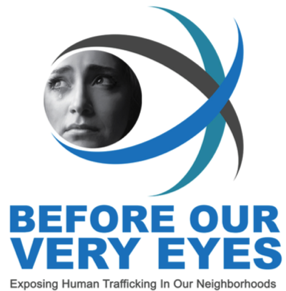Frequently Asked Questions:
1. What is the campaign you are calling Before Our Very Eyes?
Before Our Very Eyes is a campaign to raise awareness about human trafficking. Our goal is to raise awareness among people who know little about modern-day slavery in an effort to teach them how to recognize it, how to report it, and how to provide actionable means for preventing it.
2. What is “human trafficking?”
Human trafficking is a form of modern-day slavery. Traffickers use force, fraud or coercion to control victims for the purpose of exploitation. The exploitation can be for commercial sex acts or performing labor against a person’s will. The exploitation of persons under 18 years does not require force, fraud or coercion to constitute human trafficking.
Sex trafficking has been found in a wide variety of venues within the sex industry, including residential brothels, escort services, fake massage businesses, strip clubs and street prostitution.
Labor trafficking has been found in diverse labor settings including, domestic work, small businesses such as restaurants, large farms, and factories.
3. Why do we call it modern-day slavery?
· Human trafficking is slavery.
· Human trafficking involves one person controlling another and exploiting him/her for work.
· Human trafficking generates billions of dollars a year, and is not legal anywhere in the world.
· Instead of being held by law, victims are trapped physically, psychologically, financially or
emotionally by their traffickers.
4. Why is this important to the residents of San Mateo County?
· Human trafficking is happening in our neighborhoods.
· Human trafficking is the fastest growing crime in the world (and the second largest criminal industry in the world after drug dealing)
· Human trafficking is a lucrative criminal industry. It’s $32 billion a year criminal industry.
· Law enforcement officials estimate that at least half of trafficking victims in the United States are U.S. citizens.
· About 80 percent of them are female and about half are children.
· California ranks fourth in the nation for human trafficking activity.
· The Bay Area is one the two hot spots in the state of California.
5. Why aren’t more people aware that human trafficking is happening locally?
Many people victimized by human trafficking are subject to force, threat or coercion by the trafficker, so reaching out for help and getting caught by the trafficker is a huge risk to their safety.
Many victims have suffered some sort of trauma, abuse or neglect in their early life that makes them more susceptible to exploitation, and easier to condition to this way of life.
Additionally, victims of human trafficking don’t always self-identify as a victim. He/she may view himself/herself as living with circumstances that he/she had a role in creating through bad choices.
Further, victims may have a relationship with the trafficker in the sense that the trafficker is meeting basic needs for this person such as food, clothing, shelter and belonging, needs that the victim might not believe they can provide without this relationship.
With respect to sex trafficking, about 80 percent of the arrangements that occur between a sex seller and sex buyer occur online so these transactions don’t happen in view of the average person who is out and about on a daily basis.
With respect to labor trafficking, many victims don’t have an adequate understanding of their rights to wages, reasonable work hours, etc.
6. Why are you using art to raise awareness about the issue of local human trafficking?
Human trafficking is a difficult subject that most of us don’t want to confront. Sometimes good works of art can increase our awareness of a social problem in a way that the transfer of mere information cannot. Once we are aware, we are stimulated to think about a problem. If art invokes an emotional response by the viewer, this experience may involve sympathy for or empathy with others. This experience may stimulate us to do something about the social problem to which the piece refers.
7. How can I participate and support this effort?
· Resolve to “say something, if you see something” out of the ordinary. Then, report suspicious circumstances to the National Trafficking Hotline. The hotline operators will direct your information to the appropriate law enforcement officials in the area. Everyone can take down this number and put it in their contacts section of their phone: 1-888-373-7888. It’s better to risk being wrong about reporting than not to report at all.
· If someone needs immediate help, call the hotline or text HELP or INFO to BeFree (233733). It’s a rescue operation, and law enforcement needs the public to participate in the rescue of these victims. Law enforcement needs our eyes. If only law enforcement have trained eyes on this issue, it’s an uphill battle. If we can train the eyes of a citizen army, we can help take down this criminal industry.
· Like our Facebook page Facebook/BeforeOurVeryEyesSMC and share the info with your friends.
· Read books and visit websites to become better educated on this topic so that we have a means of conquering this scourge in our neighborhoods and families.
· SB 1193 & Civil Code Section 52.6 – Posting of Pubic Notices Regarding Slavery and Human Trafficking passed in 2012. This law requires certain businesses and other establishments to post the National Human Trafficking Resource Center Hotline number on their storefronts for the public and victims to seek help or report suspicious activity. We need you to post this public notice and inform others. You can read more about this law and download San Mateo County’s human trafficking hotline resource poster at BAHC2freedom.org, which is a webpage dedicated to raising awareness about SB 1193. While this law has been in effect since April 1, 2013, many businesses mandated by SB 1193 are not aware of their obligations, so please help spread the word.

